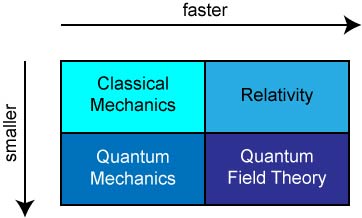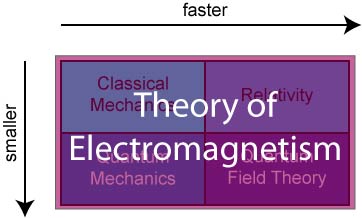Electromagnetism: Introduction
The theory of electromagnetism (sometimes still called electricity and magnetism, or E&M) is one of the most successful theories in all of physics. It is an important example of the recognition of two seemingly disparate theories--electricity and magnetism--as two different aspects of the same thing. One of the goals of physics is to unify our understanding of the four fundamental forces: gravity, electromagnetic, weak and strong forces. The electromagnetic force has already been unified from electric and magnetic forces.
In addition to this unification, the theory of electromagnetism crosses the boundaries that classical physics imposes on our understanding of the motion of objects based on their speeds and sizes. For example, Newton’s Laws only work when the object in question is large compared to the size of an atom or slow compared to the speed of light. If an object is extremely small, subatomic, you need quantum mechanics to understand its motion, and if it is extremely fast you need relativity. If it is both small and fast you need quantum field theory.[1]


The theory of electromagnetism works in all four of these areas! If you use the principles here to determine the force on a charged particle, it doesn’t matter whether that particle is macroscopic or subatomic or moving at the speed of light--your answer will be correct.
I mentioned the four fundamental forces above. All forces can be reduced to one of these four fundamental forces. If you make a list of all the forces that you have studied up to this point, it probably includes things like gravity, tension, normal force, friction, Hooke’s Law, and so on. All of these except for gravity, which is one of the four, are at a basic level, caused by the electromagnetic force. Friction results primarily from the forces between molecules in the two surfaces, and these molecular forces are electromagnetic in nature.
It is easier to say what is NOT caused by the electromagnetic force: gravity, particle decays, and most nuclear or high energy reactions.
The property of matter at the root of all electromagnetic phenomena is charge. First a brief explanation of charge, and then we'll study how charges lead to electric and magnetic effects. We will begin with the study of stationary charges: electrostatics.
[1] A very similar version of the figure on the left appears in David Griffiths' wonderful book, Introduction to Elementary Particles, 2nd Ed, 2008, p 2.